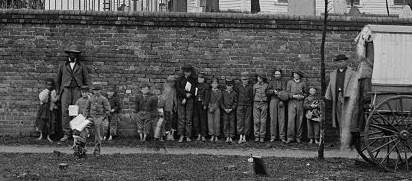

When I learned how effective Guided Inquiry could be, I got excited about planning a GID-based writing workshop. I focused on Reconstruction because it’s the setting for my book, but the model could be adapted for any historical time period. On my website I’ve posted the materials you’d need to lead this workshop in a middle or high school classroom, and I’ll run through the steps quickly here.
The “Open,” “Immerse,” and “Explore” stages are the same as I mentioned yesterday: show the book trailer, read BROTHERHOOD, ask students to connect to content, and begin to research Reconstruction. When I visit schools, I show a series of photographs, and students point out the details—clothing, means of transportation, food, etc. My favorite is this shot taken at the wall in front of St. John’s Church in Richmond, VA, in 1865. Notice that the people are wearing coats and hats, but most have bare feet.

During the “Identify” stage, I ask students to write a scene based on a newspaper article from the era. I encourage loose, messy, fast writing. I interrupt them with sound effects (church bells, horses, crickets), and ask them to incorporate the sounds into their scenes. The process here isn’t about producing good writing. It’s about entering into the time period vicariously.
Next, students swap newspaper articles and write a second scene—again, loose, fast writing. Then they pause and I ask which scene they liked most. Which did they prefer writing about, and why? What did they find compelling, disturbing, or interesting about the one they preferred? Their answers kick off the “Gather” stage of the GID process—the stage when students begin to ask their own questions. This step is the essence of Guided Inquiry. It’s the reason GID is so effective.

Whether students prefer scene A to B, or B to A doesn’t matter. What matters is that they prefer one. Students will always prefer one. Always. And the moment they articulate why they like one better than the other is the moment they really begin to invest in the subject matter. It’s an exciting moment to watch! They’re given permission to make a choice, express an opinion, and be heard, and the process empowers them.
In the “Gather,” “Create,” and “Share” stages, students’ individual or group projects go in any number of directions, and I leave that part up to the teachers. Some have particular themes they’d like the class to address. For example, in my previous post I mentioned that the teacher wanted students to think about gangs—all types of gangs and the conditions that give rise to them. Or teachers might want students to think about voting rights (who feels threatened by another’s right to vote?). Or maybe students will create and share presentations about citizenship and what it might feel like to live in America today and not be a citizen. Or they might talk about the problem of bullying.
GID allows for flexibility! I began this post talking about Reconstruction, and in only a few paragraphs, I’ve raised a myriad of topics, but that’s because my novel raises them (the Reconstruction-era amendments established birthright citizenship and voting rights; if your class is focused on a different time period, your students will ponder a different set of issues).
From my perspective—hey, I’m a writer, so I have to nudge students to write, no apologies!—an easy exercise in loose writing gets the process going strong. And when students reflect on issues that matter to them, personally, and are in a safe space for reflection, wow! Sharing happens. Listening happens. Learning happens.
I love the way GID promotes a student-centered and student-directed approach to learning (so much more effective than the memorize-and-regurgitate model of my youth). Like I said in my first post, boy do I wish my teachers had used Guided Inquiry when I was growing up. Thank you, Leslie, for inspiring me and the next generation of educators!
What a terrific lesson, Anne! The accessibility of period photographs makes a great introduction to primary sources coupled with student engagement.
So true, Nancy. And don’t get me started! I can geek-out about primary sources all day long. Throw in those sound effects, and you transport students to another day and time…